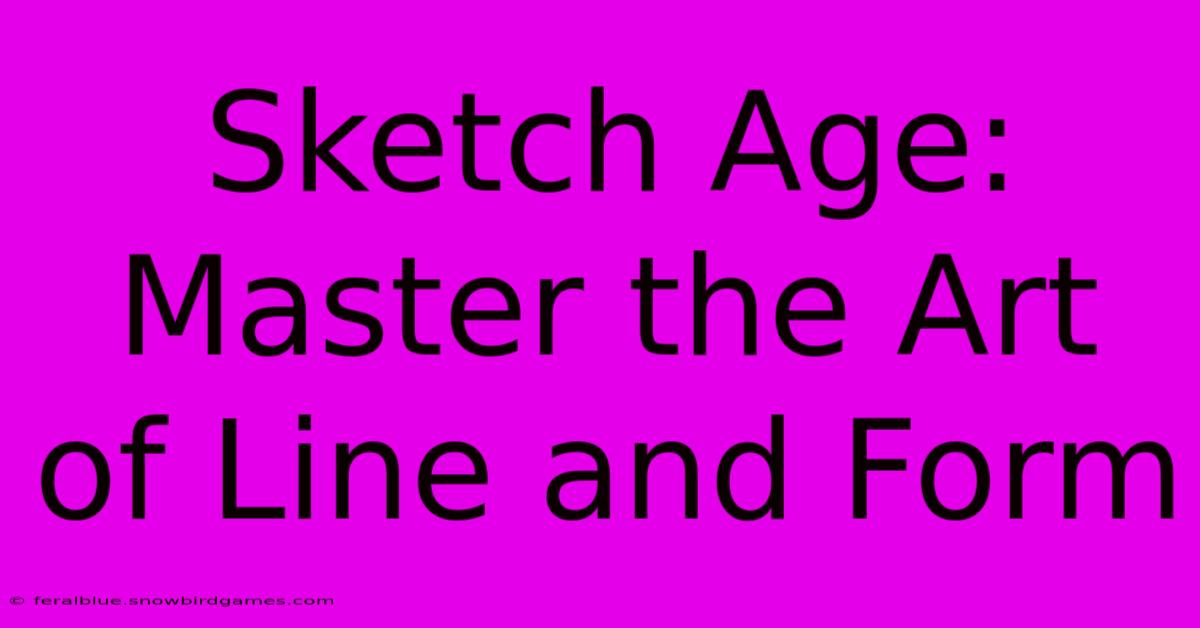Sketch Age: Master The Art Of Line And Form

Table of Contents
Sketch Age: Master the Art of Line and Form
Are you ready to unlock your artistic potential and learn how to create stunning sketches? Then you've come to the right place! This comprehensive guide dives deep into the world of sketching, focusing on mastering the fundamental elements of line and form. Whether you're a complete beginner or looking to refine your existing skills, this article will provide valuable insights and practical tips to elevate your sketching game.
Understanding the Power of Line
Line, the most basic element of drawing, is far more than just a mark on paper. It dictates movement, direction, and emotion within your artwork. Mastering line work is crucial for creating believable forms and conveying your artistic vision effectively.
Types of Lines and Their Applications
- Bold Lines: Used to create strong focal points, define solid forms, and express confidence. Think of bold outlines on a figure drawing.
- Thin Lines: Perfect for delicate details, suggesting lightness, and creating a sense of distance or subtlety. Consider the fine lines used in sketching hair or foliage.
- Curved Lines: Convey fluidity, softness, and organic shapes. Ideal for sketching flowing hair, landscapes, and rounded forms.
- Straight Lines: Create a sense of structure, precision, and stability. Essential for architectural sketching and creating geometric shapes.
- Broken Lines: Used to suggest movement, texture, or implied forms. Useful for depicting windswept hair or a rough surface.
Exercises to Improve Your Line Control
- Blind Contour Drawing: Focus on the subject without looking at your paper. This helps train your hand-eye coordination and improve observation skills.
- Hatching and Cross-Hatching: Experiment with different line weights and directions to create shading and texture. This builds a strong understanding of value.
- Line Variations: Practice drawing a single line with varying weights, curves, and angles. This develops control and fluidity.
Mastering the Art of Form Through Shading
Form is the three-dimensional representation of objects on a two-dimensional surface. Achieving a realistic and engaging representation of form relies heavily on your understanding and application of shading techniques.
Shading Techniques for Realistic Forms
- Value Scales: Create a grayscale chart to understand the range of tones from light to dark. This is your foundation for effective shading.
- Light Source: Identify the primary light source in your scene. This helps you understand where highlights, mid-tones, and shadows will fall.
- Highlights: The brightest areas reflecting light directly. Used to create a sense of volume and shine.
- Mid-tones: The areas between highlights and shadows. Used to subtly define form and create transitions.
- Shadows: The darkest areas where light doesn't reach directly. Used to create depth and dimension.
- Cast Shadows: The shadows thrown by an object onto a surface. They enhance the sense of three-dimensionality and spatial relationships.
Developing Your Shading Skills
- Practice with Basic Shapes: Start by shading simple geometric forms like spheres, cubes, and cylinders to understand how light interacts with different surfaces.
- Observe Real-Life Objects: Pay attention to how light falls on objects around you. Study the variations in tone and shadow.
- Experiment with Different Shading Techniques: Try hatching, cross-hatching, blending, and stippling to discover your preferred methods.
Combining Line and Form: The Key to Expressive Sketches
The true magic of sketching happens when you successfully integrate line and form. Strong lines define the boundaries of your subject while skillful shading brings it to life.
Tips for Integrating Line and Form
- Sketch Lightly: Begin with light lines to map out your composition and refine your forms gradually.
- Build Layers: Add layers of shading to gradually build up volume and detail.
- Don't Be Afraid to Erase: Sketching is an iterative process. Don't hesitate to erase and redraw to achieve the desired effect.
- Embrace Imperfection: Don't strive for photorealism. Focus on capturing the essence and character of your subject.
Beyond the Basics: Exploring Different Sketching Styles
Once you have a firm grasp of line and form, you can explore different sketching styles to broaden your artistic expression. Experiment with different mediums, techniques, and subjects to discover your unique artistic voice.
By consistently practicing these techniques and continually refining your skills, you’ll soon be well on your way to mastering the art of sketching and creating truly captivating pieces. Remember, the journey is as important as the destination. Enjoy the process, experiment fearlessly, and let your creativity flow!

Thank you for visiting our website wich cover about Sketch Age: Master The Art Of Line And Form. We hope the information provided has been useful to you. Feel free to contact us if you have any questions or need further assistance. See you next time and dont miss to bookmark.
Featured Posts
-
Max Verstappens Net Worth Impressive Achievements
Apr 02, 2025
-
Adam Sandler S Daughters Military Life From Starlet To Soldier
Apr 02, 2025
-
Secret Veilguard Builds Dragon Age Power Unleashed
Apr 02, 2025
-
Dad N Me Game Unleash The Fun Strengthen The Bond
Apr 02, 2025
-
Paras Shahs Daughter Her Drive To Succeed
Apr 02, 2025
